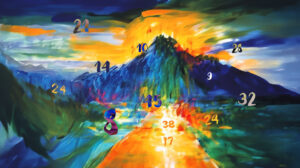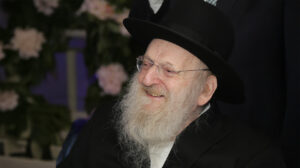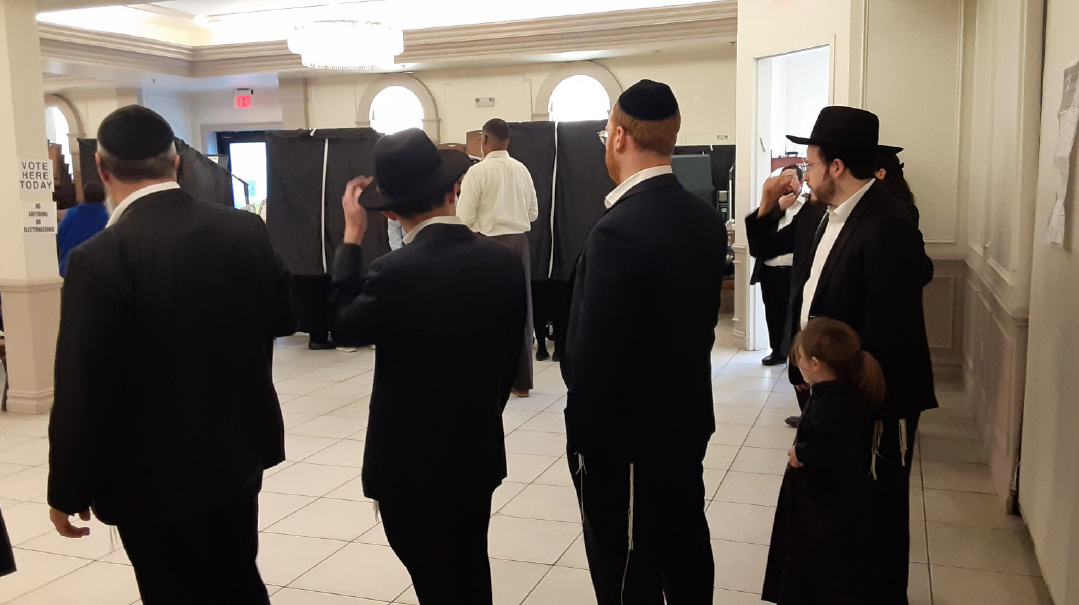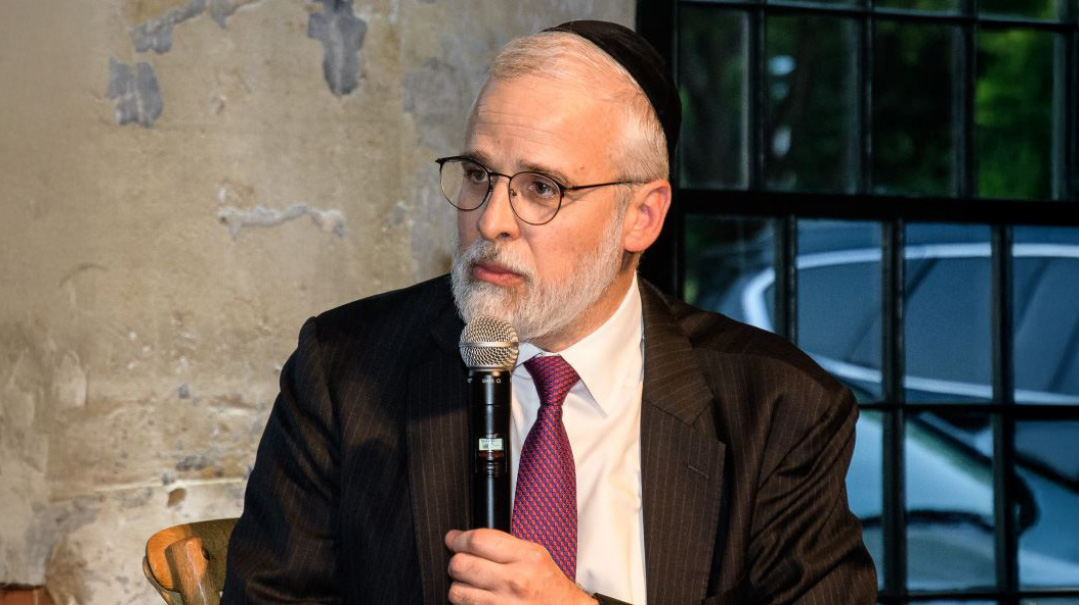Where Peace and Truth Intersect
| May 13, 2025This incredible balance of total fidelity to conflicting truths alongside deep friendship and respect is almost impossible for us to imagine

Recently, a kol korei — a pronouncement — of Agudath Israel of America’s Moetzes Gedolei HaTorah took a position on an important and controversial issue confronting Klal Yisrael. The issue itself — participation in the World Zionist Organization’s election — is not the subject of this article.
Rather, I would like to focus on one line of the kol korei, which, regardless of the underlying questions and how different rabbanim ultimately concluded, should have an enduring impact on Klal Yisrael with regard to many more issues: “We do not intend to impugn the honor of those distinguished rabbis who ruled that it is permitted. However, our opinion is that there are many issurim….”
This most important statement addresses an issue that the Jewish People have struggled with and will have to struggle with until the end of days: machlokes.
Let us first define the word “machlokes.” Usually, it is wrongly translated as “fight.” However, it should more accurately be understood as meaning “dispute.”
But why are there disputes among rabbanim at all? Many people shake their heads in despair, wondering why, when our nation is in the midst of such troubling times, the rabbanim can’t just get together and agree to a common policy. Aren’t shalom and bein adam l’chaveiro among our most important values?
These questions stem from an incomplete understanding of what Hashem is asking of us. The prophet Zechariah (8:19) promises that all the sad days of Klal Yisrael “will turn into happy festivals if truth and peace are beloved by you.” We might wonder if it’s at all possible for truth and peace to coexist, for they are dual tracks and it seems at times that never the twain shall meet.
However, there is a point at which the two intersect, and finding that point is exactly what Hashem wants of us. To distort the truth for the sake of getting along with others, on the one hand, or to generate enmity and friction by personally attacking those we disagree with, on the other, are both off the mark. The Shechinah dwells at the magical point where truth and peace intersect and are in full balance.
Let us first look at “truth.” Hashem has created every single person with unique daas, best described as “cognitive perception.” Thus, while people can come to agreement about dry objective facts, they have a broad range of opinions regarding ideas and values, and each of those opinions almost always has some element of truth to it. So how do we deal with that?
When there was a Sanhedrin, we had the most ideal way to resolve our issues. If any of the lower courts could not reach a decision, the question went to the Sanhedrin, whose ruling became the absolute halachah for every single Jew. Someone could still dissent in a conceptual way. He could offer his view in an academic setting, where he had every right to present an alternative theory.
However, no one (even another member of the Sanhedrin) was allowed to overrule or disobey the ruling of the Sanhedrin. Doing so was a capital crime. Thus, peace and truth were accomplished in tandem. The “truth” part of the equation was produced by the Sanhedrin’s deliberations and debates. The “peace” part came from the fact that their ruling had to be accepted by all.
But the Sanhedrin stands alone as the only institution that has the power to mandate a unified approach to halachah throughout Klal Yisrael. Nevertheless, since Sanhedrin’s absence, the tasks of teaching and ruling on halachah have been carried out by our rabbanim, and they must go on. The Torah must remain responsive to the needs and issues of the times in which people are living.
On a kehillah level, one “halachic truth” can still exist. In a town with one community, the local beis din or mara d’asra has the power to rule on matters of halachah, and such rulings become binding on that kehillah. Those in authority can also set various takanos for the public benefit. However, if there are two communities even in that one town, they each need to act in accordance with their own Torah leaders.
In that case, we have two communities, each acting according to the “truth” as interpreted by its rabbanim. But given their differing visions, can there be “peace” as well? Without a Sanhedrin, how can we ever reach the balanced state that Zechariah describes?
Let us examine the question by analyzing the dynamics between Beis Hillel and Beis Shammai, which may be considered the embodiment of halachic dispute. Their arguments permeate all of Shas, but in two areas specifically, these arguments should have led to an unraveling of Klal Yisrael’s social fabric. In the area of kashrus (more specifically tumah and taharah), one permitted that which the other prohibited. In the area of marriage, Beis Hillel held that some of Beis Shammai’s offspring ought to be considered mamzerim.
The result of these two disputes would seem to necessitate a complete severance of Hillel’s followers from those of Shammai. How could the two camps socialize with each other if they could not eat together or marry into each other’s families? However, the baraisa (Yevamos 14) concludes, “Although Beis Hillel and Beis Shammai argued in [these areas]… they did not refrain from marrying each other or from eating with each other. This teaches us that there was friendship and love between them, fulfilling the verse to ‘love truth and peace.’ ”
How did they establish this peace amid their conflicting truths? They did not do so by compromising their respective halachic rulings, but rather by communicating clearly with each other, informing each other of what was permissible for the other to eat and whom they were permitted to marry. This incredible balance of total fidelity to conflicting truths alongside deep friendship and respect is almost impossible for us to imagine.
This behavior exemplifies the peace aspect of the equation, the ability to remain friends despite such differences of opinion. And to an even greater extent, Hillel and Shammai’s behavior exemplified the other half of the equation: truth.
The Gemara (Eiruvin 13b) states that in most disputes, we adhere to Beis Hillel’s rulings. The reason for this is “because they [Beis Hillel] were humble, and not only studied Beis Shammai’s opinion, but would even start by first considering Beis Shammai’s opinion.” This does not mean that simply because of their good middos, they were rewarded with confirmation of their halachic decisions. Rather, it means that because they considered Beis Shammai’s opinion first, and in an unbiased manner, their understanding was fuller and closer to the truth.
To arrive at the truth, a person must consider the other side with an open mind. Not only before his decision, but even afterward, he needs to be willing to consider other approaches. Thus, the Mishnah (Eduyos 1:4) teaches us that we record a halachah that has been retracted by its proponent “to teach us that one should always be open to retracting one’s viewpoint in face of the truth.”
The Rambam in his introduction to his commentary on the Mishnah states:
And the reason that required them to write the opinion of a man and afterwards that he recanted from that opinion — for example, when they said, “The House of Shammai said like this and the House of Hillel said like this and that, and the House of Hillel recanted to instruct like the words of the House of Shammai” — is in order to inform you of [the need for] the love of truth and the power of righteousness and faith.
And behold, when these honorable, pious, and magnanimous men, who were outstanding in their wisdom, saw that the words of the one who is in disagreement with them were better than their words and [that] their investigation was correct, they conceded to him and recanted their [own] opinion. All the more so, when other people see that the truth is leaning toward the one with whom they have a conflict, [such a one] should lean toward the truth and not stiffen his neck. And this is the [meaning of the] verse (Devarim 16:20), “Justice, justice shall you pursue.”
A distressing example of what it means to stifle Torah debate is written by the Chayei Adam (who lived in Vilna and held the Vilna Gaon in the highest possible esteem), in his introduction to Binas Adam. He states:
I bring very few points from my esteemed mechutan, the gaon and kadosh of Israel, the one whose waters we drink, the extraordinary mekubal and chassid Rav Eliyahu [the Vilna Gaon] ztz”l. The reason that I quote so few points from him is that people were upset with me that in a few places in my previous work, Chayei Adam, I had written contrary to his opinion and brought proof against his position.
The people who complained are certainly people who do not understand what it means to learn, and to learn halachah. They don’t understand that this is the way of Torah; that one builds and the other topples, a student can argue with his teacher, just like you see the Tur arguing with his father the Rosh, and as is often evidenced in Shulchan Aruch and the poskim.
This is like Rav Yochanan who commented about Reish Lakish, who kept asking questions on his teachings, that “between the two of us, we’re able to properly come to the appropriate halachah.” This debate is certainly a great source of nachas to the Vilna Gaon; a lot more than somebody just nodding along in passive consent. All these people who opposed this are going to be held accountable for depriving this nachas from the Gaon…”
This clearly shows us the need for Torah discussion of a back-and-forth nature, which allows for expressions of different learned opinions. In this way, the halachah becomes crystalized.
Thus, we arrive at the truth.
How indeed do we arrive at peace while we’re putting forth our view? It’s not by watering down our stance — not at all. When we argue about the point at hand, we need to be passionate. The key to the “peace” part of the equation is that nothing in our argument should ever translate into a personal attack.
I personally heard from Rav Aryeh Finkel ztz”l an extraordinary story demonstrating this point:
Rav Finkel’s mother was a stepdaughter of Rav Yosef Chaim Sonnenfeld. She told Rav Aryeh Finkel that the kana’im of Yerushalayim once came to Rav Sonnenfeld and complained, “You send mixed messages. On the one hand you call Rav Kook an apikorus, and on the other hand you honor him greatly, and treat him with great dignity.”
Rav Sonnenfeld replied, “Chas v’shalom, that I would have called Rav Kook an apikorus. What I said was that certain things that he writes are apikorsus, but the person is the furthest thing from being an apikorus.”
What he meant to say obviously was that he held Rav Avraham Yitzchak HaKohein Kook in great esteem but argued strongly against particular points that he made. That is how we arrive at peace — by respecting the person we are disagreeing with.
In this period of the year, when the entire world of Torah collapsed because of the breakdown of mutual respect among Rabi Akiva’s talmidim, we must redouble our efforts to repair our approach to dispute.
First, we need to recognize that the real emes is only achieved by viewing all valid opinions (i.e., people who are dedicated to Torah and yiras Shamayim and are of the caliber to weigh in on a particular issue). We must honestly consider the other side and always be prepared to reconsider; that is the love of emes.
Furthermore, we must respect and treat with the utmost dignity those with whom we disagree, no matter how strong the disagreement is; that is the love of shalom.
Rav Yehuda Leib Levin, the grandson of the Imrei Emes, relates an extraordinary story portraying both the challenge and the correct approach to it (Megillas Polin–Izhbitza, p. 39). The background to this story is the terrible conflict between the chassidim of Kotzk and those of Izhbitz. The Izhbitzer Rebbe had been a very close disciple of the Kotzker. He became convinced that the Kotzker’s demand for absolute uncompromising emes was too tough for the larger community to follow. He therefore broke away and established his own dynasty. The machlokes was wrenching and created a lot of enmity among the chassidim.
There were two chassidim who were partners in a business venture. One was a Kotzker chassid, and the other was an Izhbitzer chassid. They disagreed with each other’s brand of chassidus but kept the dispute out of their business, and indeed their business thrived.
At some point their business began to fail, and the Izhbitzer chassid became gravely ill. He tried to go to his Rebbe to ask for a brachah, but he couldn’t make the trip. Having no option, he finally turned to his partner and implored him to please go and ask the Izhbitzer Rebbe for his blessings. The partner really did not want to go, but he couldn’t refuse his friend in such terrible circumstances.
Rav Tzaddok HaKohein happened to be in the room with the Izhbitzer Rebbe when this chassid arrived, and he said that the conversation made him cringe. He left the room but was still able to overhear the conversation from outside.
The Kotzker chassid barged in without even saying “Shalom,” and declared, “I did not come as a follower, but as somebody who’s been forced to do a mission. My partner forced me to tell you that he’s very sick and that that our business is collapsing.”
The Izhbitzer Rebbe asked him, “What will you say if you see a miracle happen and your friend gets well?”
The Kotzker chassid answered, “I will say that this is the result of kishuf, not of kedushah.”
The Rebbe continued, “And if I show you that it is not kishuf, what will happen then?”
“No, I will not become convinced,” the chassid was adamant.
“And what will be with your emes?” the Rebbe persisted.
“Emes is to be found in Kotzk, an emes that I acquired with my blood, and I will not move from it, nor exchange it for anything in the world.”
The Rebbe replied, “Tell your partner not to worry. He will recover and the business will prosper. And you — because of the mesirus nefesh that you showed for the emes as you see it, you will merit having extraordinary children.”
This was the incredible middas hashalom of the Izhbitzer, truly admiring the middas ha’emes of Kotzk!
Following this line of behavior seems beyond us. But we need to note that the Navi does not tell us that if we perfect the balance of emes and shalom, then Mashiach will come. Rather, he states that if we genuinely cherish these twin values, our days of mourning will turn to joy.
We need to work toward both with equal fervor. We need to strive for understanding emes without wavering in our commitment. And with equal fervor, we need to value and cherish other people whose opinions and actions are coming from a true Torah perspective, from real yiras Shamayim, and from their genuine search for emes. —
Rav Aaron Lopiansky has authored several seforim, including the recently released Orchos Chaim, Ben Torah for Life.
(Originally featured in Mishpacha, Issue 1061)
Oops! We could not locate your form.












